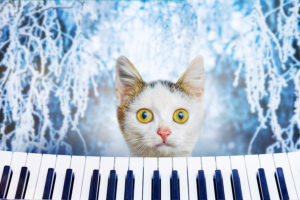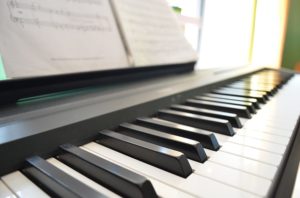
A small white kitten on a winter background with a funny look near the piano. Advertising of musical instruments
Are you wondering how to protect your piano in the winter? You’re in the right place! You’ll find several tips below to help you keep your piano in fine shape no matter what the weather outside.
Depending on where you live, it can get very cold in winter. Even in Central Virginia, we have days where we have sub-freezing temperatures. And yes, we get snow too, sometimes a lot of it.
About Temperature
To keep your piano safe, it is first of all important to keep the temperature around your piano steady, preferably around 70 degrees. And that’s what it should be all year long.
This means that you should have your thermostat set to your regular temperature and keep it there, whether you’re home or not. Even if you’re on vacation for a week, you should still keep the room with your piano at that temperature, or you might be coming back to a piano that is out of tune.
Why You Should Keep The Temperature Steady
Hot and cold temperatures can have negative effects on your piano. Cold temperatures can weaken some of the delicate wooden parts of your piano, for example. And once they’re weakened, they could snap and break your piano. Heat has a bigger effect on the metal parts. But the biggest reason is something else that comes along with hot and cold temperatures…
About Humidity
Humidity fluctuates as the temperature fluctuates. If it’s cold, humidity levels are low. And when it gets hot, they rise. You know about hot and humid days, and you also know about chapped lips and dry skin when it’s cold. That’s the effect of humidity.
When it comes to your piano, humidity can really affect especially the wooden parts. They’ll expand when the humidity is high, and shrink when it is low. And that can lead to damage to the piano, as well as to the piano going out of tune.
How to Protect Your Piano In the Winter
To protect your piano in the winter against potential damage, be sure to keep both temperature and humidity steady. The temperature should be around 70 degrees, i.e., regular room temperature. The humidity should be around 40 degrees. Of course, that’s also true when you want to protect your piano in the summer...
You could use A/C to keep the temperature steady, and if needed, you can also use a humidifier if the air gets too dry in the winter.
How would you know if the air is too dry (or to humid)? You can use a hygrometer. They’re easily available from Amazon, or you could ask your piano tuner for a recommendation.
There are also humidity control systems available, but you probably won’t need one if you can control the humidity at your home in other ways, either through your A/C or by using a humidifier and/or a dehumidifier as needed.
Some Common Sense Tips
There are also some common sense things you can do, such as keeping the windows closed on humid and rainy days… And, of course, always keep your piano away from heaters and drafts.
Any questions? Blanton Bendall, your Richmond Piano Tuner will be happy to answer them for you. And if it’s time for him to tune your piano, he’ll be glad to make specific recommendations on how to protect your piano in the winter.
Just send him a text message at 804-677-2416 for the fastest response, or call him at that number. You may also want to visit our Southern Piano Service Facebook page (and like it while you’re there).
 It’s summer in Richmond and Central Virginia again, and temperatures are inching up. So does the humidity. t’s time to find out how to protect your piano in the summer from excess heat and humidity as well as temperature and humidity fluctuations. It’s also a good idea to find out whether you need a humidity control system for your piano.
It’s summer in Richmond and Central Virginia again, and temperatures are inching up. So does the humidity. t’s time to find out how to protect your piano in the summer from excess heat and humidity as well as temperature and humidity fluctuations. It’s also a good idea to find out whether you need a humidity control system for your piano.

